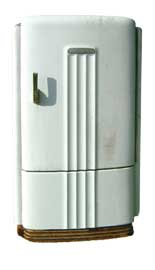Buried Treasures: Unearthing Time Capsules - Page 4
A time capsule should preserve more than a home or a neighborhood's early history, says Jerry Escobar, who lives in an Eichler in San Jose. It should also capture life as it is lived. He recently returned home to find some neighbors and their children passing time outside. "Next thing," he says, "we're all in the driveway having an impromptu party." What better content than a photo of that for his time capsule? "This is a group of our friends," he says. "This is what life is like in 2007." He'd also do a few top-fives: "Favorite things we like to do, our favorite gadgets, favorite TV shows. I'd throw an ipod in right now. A laptop would be nice, but it's too expensive." He'd put in a photo of a laptop instead. "If you're into beer, or cocktails, put in your favorite beer," he says. "Put in a martini glass. Throw in your favorite bottle of wine."
Time capsules can get downright serious—painfully so. Back in 1939 for the New York World's Fair, Westinghouse filled a corrosion-resistant copper alloy capsule with hundreds of items, ranging from an alarm clock and alphabet blocks to a stylish ladies hat and hundreds of publications on microfilm.
Wayne Donaldson, when an architecture student at Cal Poly San Luis Obispo, was far less ambitious when he and a group of fellow students in the '60s started filling refrigerators with stuff and burying them in the hills. "They're almost like coffins in a way," he says of refrigerators. "They really work very well and keep bugs out."

Inside their capsules, Donaldson and his crew buried "lava lamps, Melamine dishes, photos of everything. A lot of plastic stuff. Plastic was just coming of age. The latest records. Things that were really well-designed and well-made, and kitschy stuff. Whatever was new for the year." The former students plan to dig up the half-dozen or so capsules themselves—when they hit 80.
Donaldson, the state of California's historic preservation officer, is also the owner of a Futuro, a plastic, saucer-shaped home from the '60s that he's installed in the San Jacinto Mountains, near Palm Springs.
Over the years, he has discovered the occasional time capsule when restoring an old building. In a Santa Barbara adobe he found a capsule with newspapers from 1906, buttons, coins, a comb, marbles, and badges from an Odd Fellows lodge. "They didn't tell a story. They tell you what was around," he says. "But the reason people leave certain things is a mystery to me. That's the fun thing about it."
What should people who cherish their modern homes preserve in their own time capsules? "I think they should put their story in there," he says. "Since this is a rebirth, ask the question 'why?' What's so important about living in an Eichler? Tell their story. I think that would be kind of fun."
Photos: John Eng, Larry Merkle, Ernie Braun; and courtesy Tulsa Historical Society, Scott Kennedy collection
Splash illustration: courtesy JoT House, Inc. - Yeh+Jerrard architects
- « first
- ‹ previous
- 1
- 2
- 3
- 4




